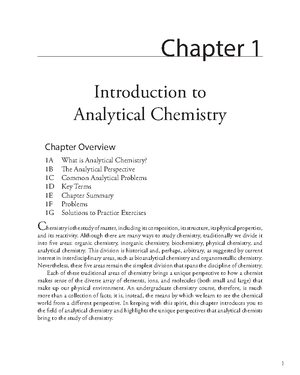- Information
- AI Chat
Was this document helpful?
Analytical chemistry-61
Course: Analytical Chemistry (CHEM 203)
999+ Documents
Students shared 1837 documents in this course
Was this document helpful?

•Globally assessing analytical processes (see Slides 3.21 and 3.22) by application
to a certified reference material (CRM) and statistical comparison of the results
for the CRM and the samples.
4.8.2. These are selected examples of the two types of calibration in the ana-
lytical process.
4.1.5 Preliminary Operations of the Analytical Process
(23 Slides)
4.1.5.1 General Features (4 Slides)
Slide 4.9
4.1.5. Preliminary operations (I)
Chapter 4: Generalities of the analytical process
yp ()
anal tical
4.1.5.1. GENERAL FEATURES (A)
First step of the analytical process
Sub-step separating the uncollected, unmeasured, untreated
sample from measurement of its signal (second step)
Purposes
(1) Facilitating the analytical process
(2) Improving analytical properties
Features (negative)
(B) COMPLEXITY
(C) HEAVY HUMAN
“Bottleneck”
of CMP
(C) HEAVY HUMAN INVOLVEMENT
(D) SLOWNESS
(E) SOURCE OF ERRORS Systematic
(F) DIFFICULT TO CONTROL
(G) SOURCE OF HAZARDS TO OPERATOR AND THE ENVIRONMENT
Accidental
(A) VARIABILITY
4.9.1. Slides 4.9–4.31 are concerned with the preliminary operations of the
analytical process. The first four (4.9–4.12) explain its general features, the next
eleven (4.13–4.23) sample collection and the last eight (4.24–4.31) sample treat-
ment (with special emphasis on separation systems).
This slide defines “preliminary operations”, which comprise sample collection
and preparation (see Slide 4.7). Also, its describes their general purposes (namely,
facilitating the analytical process and improving analytical properties) and their
seven most salient features, which are as follows:
4.1 Explanation of the Slides 167
Students also viewed
- Analytical chemistry-58
- Special Education Needs in Secondary Education
- Inclusive Education for Diverse Learners
- 4 Assessment and Evaluation in Secondary Education
- The concept of the ‘rule of law’ is paradoxical
- The Composition of Parliament and Parliamentary Elections- Almost anyone can be a member of the House of Lords
Related documents
- The Conduct of Campaigns is concerned with parliamentary elections but the same principles apply to the various other elections
- Principles of Constitutional Law in Scotland- economic and social integration
- Public Order- Public demonstrations and meetings are an important expression of democracy
- Police Accountability- The question of police accountability raises three main constitutional issues
- Party Politics- The local electoral system gives less opportunity for party dominance than is the case with central government
- Parliamentary Privilege and Standards- Interference by the Crown with parliamentary business















